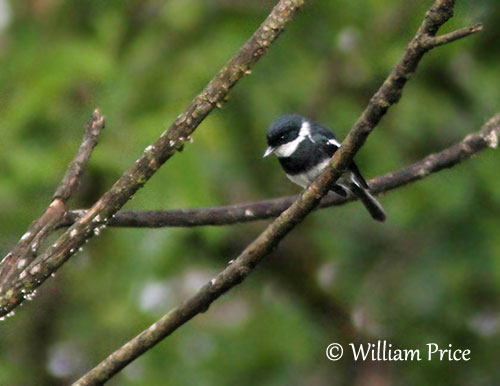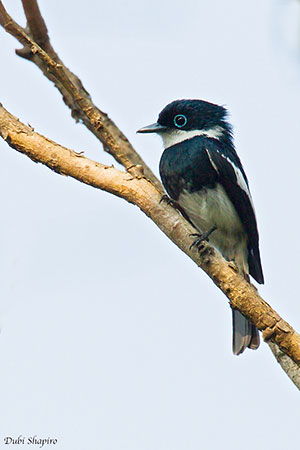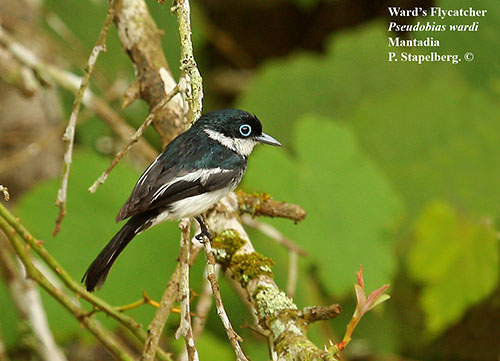
During the breeding season, the Ward’s Flycatcher becomes highly territorial, and some fights may occur between several birds. They call loudly while flying at each other, and contact occurs in mid-air. Following the disputes, the birds fly off in different directions. They are probably monogamous.
The Ward’s Flycatcher is resident in its range.
It is generally agile in flight, and especially while hunting.
REPRODUCTION OF THIS SPECIES:
From an observation of one nest with young, the laying occurs in October/November.
The cup-shaped nest was made with tightly woven plant material including moss and grass, with spider webs wrapped around the outer part. It was placed in tree fork, 6-8 metres above the ground. (However, it is not certain that this nest belongs to this species due to the location in Montagne d’Ambre - Koenig 1993).
An immature was found in December. Both adults build the nest and feed the young. No more information.
PROTECTION / THREATS / STATUS:
The Ward’s Flycatcher is common in suitable habitat, but rather patchily distributed throughout the range. It is vulnerable to habitat destruction through clearance for agriculture expansion.
The species is not globally threatened, and currently evaluated as Least Concern.
Fr: Bias de Ward
Ang: Ward’s Flycatcher
All: Wardschnäpper
Esp: Bias de Ward
Ita: Pigliamosche di Ward
Nd: Wards Vliegenvanger
Sd: flugsnapparvanga
Mal: Serikalambo, sohihy mangavola, Vorombarika, Vorona masiaka
Photographers:
William Price
PBase-tereksandpiper & Flickr William Price
Dubi Shapiro
Dubi Shapiro Photo Galleries
Philip Stapelberg
GALLERY
Text by Nicole Bouglouan
Sources:
HANDBOOK OF THE BIRDS OF THE WORLD Vol 11 by Josep del Hoyo, Andrew Elliott and David Christie - Lynx Edicions - ISBN: 849655306X
The Birds of Africa: Volume VIII: The Malagasy Region: Madagascar, Seychelles, Comoros, Mascarenes - Par Roger Safford, Frank Hawkins – ISBN: 1408190494, 9781408190494- Editeur: A&C Black, 2013
Birds of Madagascar: A Photographic Guide Par Pete Morris, Frank Hawkins – ISBN: 0300077556, 9780300077551- Editeur: Yale University Press, 1998
Wildlife of Madagascar par Ken Behrens, Keith Barnes - ISBN: 140088067X, 9781400880676 – Editeur: Princeton University Press, 2016
Birds of the Indian Ocean Islands Par Ian Sinclair, Olivier Langrand - ISBN: 1868729567, 9781868729562- Editeur: Struik, 2003
Ward’s Flycatcher
Pseudobias wardi
Passeriformes Order – Vangidae Family
INTRODUCTION:
The Ward’s Flycatcher is endemic to Madagascar where it occurs usually at mid-elevation in the eastern rainforest. It is sometimes confused with the Chabert’s Vanga. It feeds on insects caught by aerial behaviour like a flycatcher. It sings from exposed perches and becomes very territorial during the breeding season. It is probably monogamous.
The Ward’s Flycatcher is usually common in suitable habitat throughout its range. Like numerous Madagascar species, it is vulnerable to habitat destruction, but currently, it is not globally threatened.
The Ward’s Flycatcher is the sole member of genus Pseudobias. It was formerly included in the family Platysteiridae that occurs in continental sub-Saharan Africa and some offshore islands. The Ward’s Flycatcher was named Ward’s Shrike-flycatcher. It was the only one that has colonized the island of Madagascar. But several morphological features, vocalizations and behaviour make it different from the other members of the family. It appears finally that this species may be an off-shoot of the endemic passerine lineage of Madagascar, the Vangidae.

RANGE:
The Ward’s Flycatcher is restricted to eastern Madagascar.
HABITAT:
The Ward’s Flycatcher frequents the humid forests of the E of the island and also adjacent second forest, from sea-level up to 1,800 metres of elevation. It favours mainly the edges for hunting. There is a recent observation in dry forest in Nosy Hara archipelago.
CALLS AND SONGS: SOUNDS BY XENO-CANTO
The Ward’s Flycatcher gives short, dry, metallic trill “pttttttt” slightly descending and repeated every 2-3 seconds. This call may be followed by faster “pt-chichichichi” of about 2 seconds. It calls from exposed perch in forest or at the edge. Several individuals often call together.
The song resembles that of the Madagascar Magpie-Robin but it is currently not described.
BEHAVIOUR IN THE WILD:
The Ward’s Flycatcher feeds on insects such as hymenopterans and coleopterans caught on the wing like a flycatcher.
It often forages at forest edge or in middle and upper storeys. It is always very active. It hunts by hawking and on the wing, performing short flight from perch where it adopts an upright posture. It often changes of perch, but it returns usually to the same branch.
It is usually seen alone or in pairs, but also in mixed-species flocks among larger species.

DESCRIPTION OF THE BIRD:
Biometrics:
Length: 15 cm
Weight: around 12-13 gr
The Ward’s Flycatcher adult male has black upperparts and head with blue sheen. We can see a conspicuous white wingbar on the wing-coverts. The tail is fairly long (57-65 mm).
The underparts are white, except the broad, black breast band. The flanks are greyish. Chin, throat and neck sides are white, forming a half collar.
The bill is greyish-blue with black tip. The eyes are brown, surrounded by fleshy, bright blue eyering. Legs and feet are blackish.
The female resembles male but the breastband is less glossy.
The juvenile has duller and slightly browner crown, upperparts and breast band. The narrower eyering is duller than in adult.
